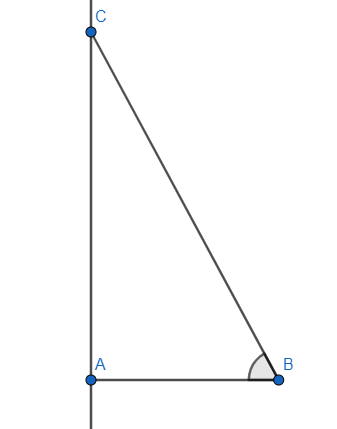Answer
385.5k+ views
Hint: We explain the function $\arctan \left( x \right)$. We express the inverse function of tan in the form of $\arctan \left( x \right)={{\tan }^{-1}}x$. We draw the graph of $\arctan \left( x \right)$ and the line $x=8$ to find the intersection point. Thereafter we take the sec ratio of that angle to find the solution. We also use the representation of a right-angle triangle with height and base ratio being 8 and the angle being $\theta $.
Complete step-by-step solution:
The internal part \[{{\tan }^{-1}}8\] of \[\sec \left( {{\tan }^{-1}}8 \right)\] is an angle. We assume \[{{\tan }^{-1}}8=\theta \].
This gives in ratio \[\tan \theta =8\]. We know \[\tan \theta =\dfrac{\text{height}}{\text{base}}\].
We can take the representation of a right-angle triangle with height and base ratio being 8 and the angle being $\theta $. The height and base were considered with respect to that particular angle $\theta $.

In this case we take $AB=x$ and keeping the ratio in mind we have $AC=8x$ as the ratio has to be 8.
Now we apply the Pythagoras’ theorem to find the length of BC. $B{{C}^{2}}=A{{B}^{2}}+A{{C}^{2}}$.
So, $B{{C}^{2}}={{x}^{2}}+{{\left( 8x \right)}^{2}}=65{{x}^{2}}$ which gives $BC=\sqrt{65}x$.
We need to find \[\sec \left( {{\tan }^{-1}}8 \right)\] which is equal to \[\sec \theta \].
This ratio gives \[\sec \theta =\dfrac{\text{hypotenuse}}{\text{base}}\]. So, \[\sec \theta =\dfrac{BC}{AB}=\dfrac{\sqrt{65}x}{x}=\sqrt{65}\].
Therefore, \[\sec \left( {{\tan }^{-1}}8 \right)\] is equal to \[\sqrt{65}\].
Note: We can also apply the trigonometric image form to get the value of \[\sec \left( {{\tan }^{-1}}8 \right)\].
It’s given that \[\tan \theta =8\] and we need to find \[\sec \theta \]. We know $\sec \theta =\sqrt{1+{{\tan }^{2}}\theta }$.
Putting the values, we get $\sec \theta =\sqrt{1+{{\tan }^{2}}\theta }=\sqrt{1+{{8}^{2}}}=\sqrt{65}$.
Complete step-by-step solution:
The internal part \[{{\tan }^{-1}}8\] of \[\sec \left( {{\tan }^{-1}}8 \right)\] is an angle. We assume \[{{\tan }^{-1}}8=\theta \].
This gives in ratio \[\tan \theta =8\]. We know \[\tan \theta =\dfrac{\text{height}}{\text{base}}\].
We can take the representation of a right-angle triangle with height and base ratio being 8 and the angle being $\theta $. The height and base were considered with respect to that particular angle $\theta $.

In this case we take $AB=x$ and keeping the ratio in mind we have $AC=8x$ as the ratio has to be 8.
Now we apply the Pythagoras’ theorem to find the length of BC. $B{{C}^{2}}=A{{B}^{2}}+A{{C}^{2}}$.
So, $B{{C}^{2}}={{x}^{2}}+{{\left( 8x \right)}^{2}}=65{{x}^{2}}$ which gives $BC=\sqrt{65}x$.
We need to find \[\sec \left( {{\tan }^{-1}}8 \right)\] which is equal to \[\sec \theta \].
This ratio gives \[\sec \theta =\dfrac{\text{hypotenuse}}{\text{base}}\]. So, \[\sec \theta =\dfrac{BC}{AB}=\dfrac{\sqrt{65}x}{x}=\sqrt{65}\].
Therefore, \[\sec \left( {{\tan }^{-1}}8 \right)\] is equal to \[\sqrt{65}\].
Note: We can also apply the trigonometric image form to get the value of \[\sec \left( {{\tan }^{-1}}8 \right)\].
It’s given that \[\tan \theta =8\] and we need to find \[\sec \theta \]. We know $\sec \theta =\sqrt{1+{{\tan }^{2}}\theta }$.
Putting the values, we get $\sec \theta =\sqrt{1+{{\tan }^{2}}\theta }=\sqrt{1+{{8}^{2}}}=\sqrt{65}$.
Recently Updated Pages
How many sigma and pi bonds are present in HCequiv class 11 chemistry CBSE

Why Are Noble Gases NonReactive class 11 chemistry CBSE

Let X and Y be the sets of all positive divisors of class 11 maths CBSE

Let x and y be 2 real numbers which satisfy the equations class 11 maths CBSE

Let x 4log 2sqrt 9k 1 + 7 and y dfrac132log 2sqrt5 class 11 maths CBSE

Let x22ax+b20 and x22bx+a20 be two equations Then the class 11 maths CBSE

Trending doubts
Fill the blanks with the suitable prepositions 1 The class 9 english CBSE

At which age domestication of animals started A Neolithic class 11 social science CBSE

Which are the Top 10 Largest Countries of the World?

Give 10 examples for herbs , shrubs , climbers , creepers

Difference between Prokaryotic cell and Eukaryotic class 11 biology CBSE

Difference Between Plant Cell and Animal Cell

Write a letter to the principal requesting him to grant class 10 english CBSE

Change the following sentences into negative and interrogative class 10 english CBSE

Fill in the blanks A 1 lakh ten thousand B 1 million class 9 maths CBSE



